Floating Market Vietnam, a unique and captivating aspect of the country’s rich cultural heritage, offer an unforgettable experience for visitors eager to delve into the local way of life. These vibrant waterways serve as lively marketplaces where vendors navigate their boats laden with fresh produce, handmade crafts, and traditional delicacies. To fully immerse oneself in this captivating cultural experience, here are some essential tips to guide your exploration of Vietnam’s floating markets.
History of Floating Market Vietnam
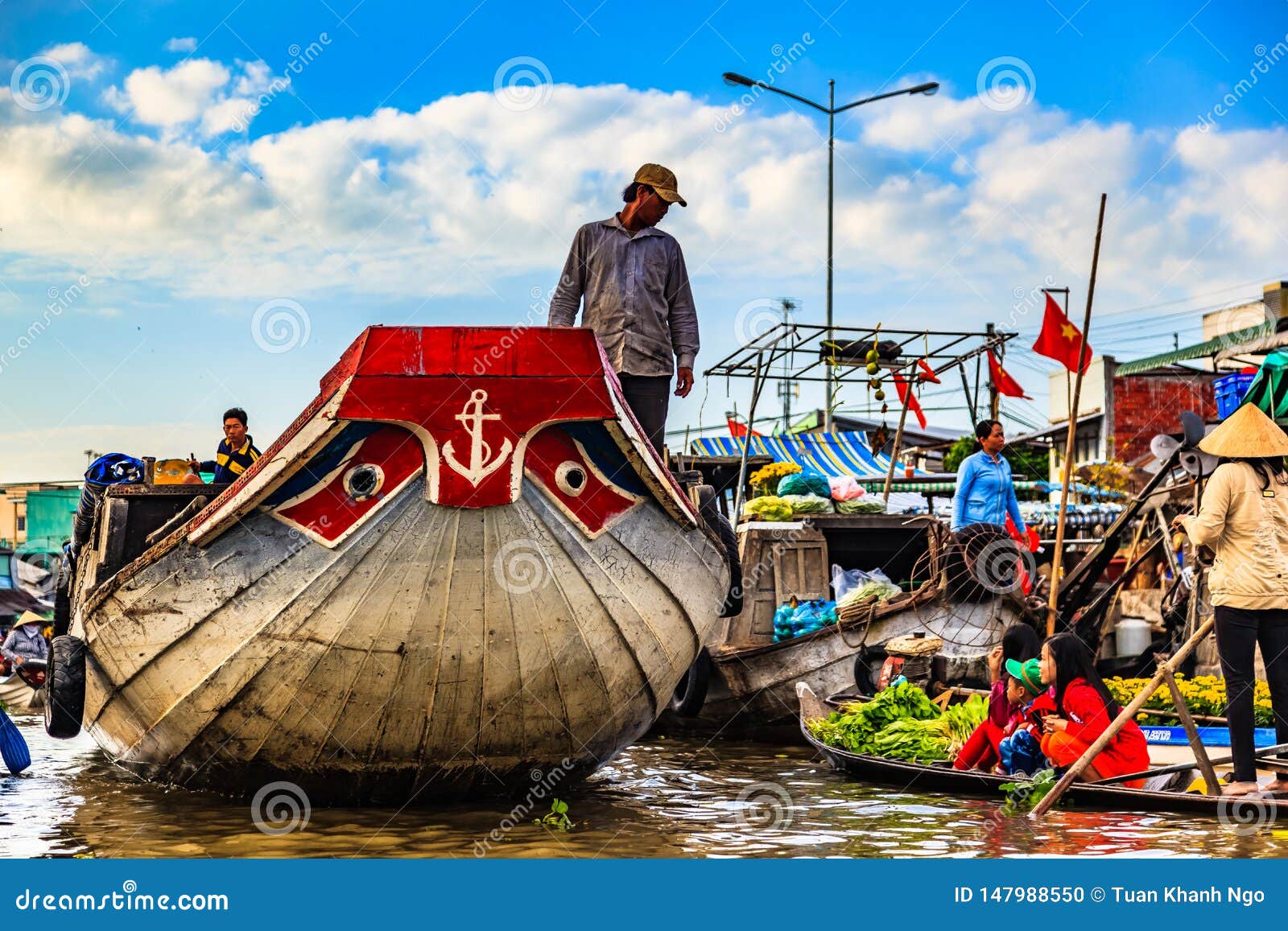
Dating back centuries, floating markets in Vietnam emerged as a convenient means of trading goods in areas with intricate waterways and limited road infrastructure. The Mekong Delta, in particular, is renowned for its extensive network of floating markets, contributing to its economic and social fabric. These markets have played a significant role in the livelihoods of local communities, fostering connections between people and facilitating the exchange of goods.
Origins of Floating Markets
The concept of floating markets can be traced back to the agrarian-based societies of ancient Vietnam, where waterways served as vital transportation routes for goods and people. As communities settled along rivers and canals, a natural trading system evolved, with boats serving as mobile marketplaces.
Adaptation to Local Geography
The Mekong Delta’s unique geography, characterized by a vast network of rivers, canals, and tributaries, made Floating Market Vietnam a practical and efficient solution for trading and distributing goods. The limited land area and the abundance of waterways made these markets an integral part of the region’s culture and economy.
Cultural Significance and Traditions
Beyond their practical purpose, floating markets in Vietnam have become deeply ingrained in the local culture, with their own customs and traditions. The markets have fostered a sense of community, where vendors and buyers interact, exchange stories, and maintain long-standing relationships.
Top Floating Markets to Visit in Vietnam
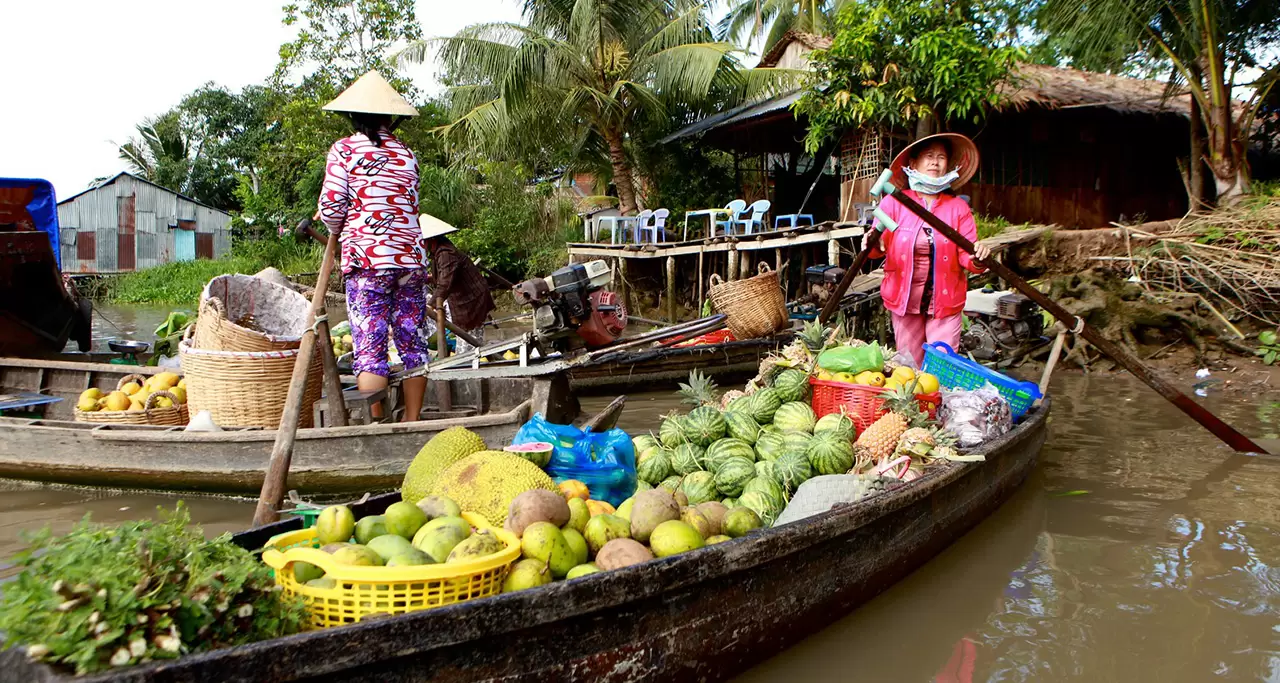
Vietnam is home to numerous vibrant floating markets, each offering a unique glimpse into the country’s rich cultural tapestry. Here are some of the most popular and renowned markets to explore:
Cai Rang Floating Market (Can Tho)
The largest Floating Market Vietnam in the Mekong Delta, Cai Rang offers a bustling spectacle of boats selling a vast array of produce, from tropical fruits to fresh seafood and vegetables. Visitors can witness the lively trading activities, haggle with vendors, and savor the authentic local cuisine served from floating kitchens.
- Opening Hours: The market is most active in the early morning hours, typically from around 5 AM to 8 AM.
- Highlights: Witness the iconic “hanging merchandise” display, where vendors hang their goods from long poles attached to their boats, signaling their wares to potential buyers.
- Getting There: Cai Rang Floating Market is located in Can Tho, the largest city in the Mekong Delta. Visitors can hire a boat or join a guided tour to experience the market.
Phong Dien Floating Market (Can Tho)
Situated near Can Tho, Phong Dien Floating Market is a smaller but equally captivating destination. Known for its vibrant atmosphere and diverse offerings, this market attracts both locals and visitors alike.
- Opening Hours: The market operates daily, with peak hours in the early morning.
- Highlights: Explore the narrow canals lined with vendors selling everything from fresh produce to handmade souvenirs and traditional snacks.
- Getting There: Phong Dien Floating Market is accessible by boat or guided tour from Can Tho.
Nga Nam Floating Market (Soc Trang)
Located in Soc Trang Province, Nga Nam Floating Market is a unique destination that combines a traditional market experience with a beautiful natural setting. Visitors can observe the daily life of locals as they trade goods and interact with one another.
- Opening Hours: The market operates daily, with the busiest hours in the early morning.
- Highlights: Immerse yourself in the serene ambiance of the market, surrounded by lush greenery and the gentle flow of the river.
- Getting There: Nga Nam Floating Market is accessible by boat or guided tour from Soc Trang City.
Traditional Boats Used in Vietnamese Floating Markets
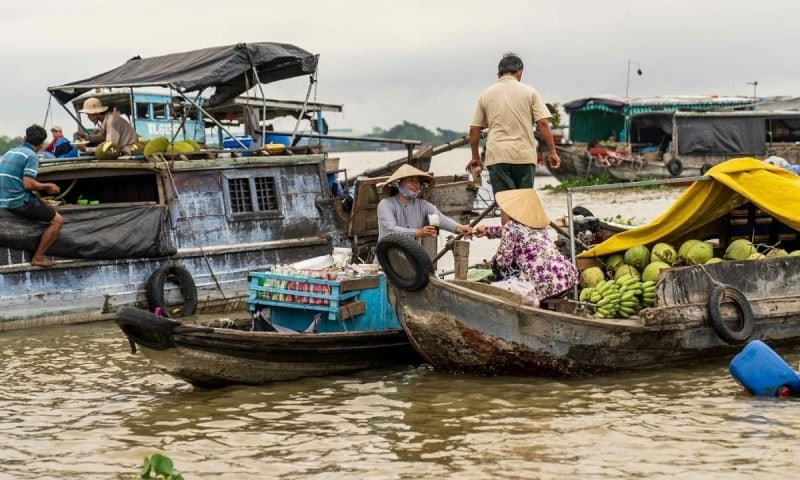
The boats used Floating Market Vietnam are not just vessels for transportation but also integral components of the cultural experience. Each boat is carefully designed and crafted to suit the needs of the vendors and the unique environment of the waterways.
Sampan Boats
Sampan boats are the most common type of vessel found in Vietnamese floating markets. These flat-bottomed wooden boats are highly maneuverable, allowing vendors to navigate the narrow canals and waterways with ease. Sampans are often adorned with colorful decorations and embellishments, adding to the vibrant atmosphere of the markets.
Rowing Boats
Rowing boats, also known as “xuong” in Vietnamese, are traditional vessels propelled by oars. These narrow boats are commonly used by vendors selling smaller quantities of goods or offering services like boat rentals or transportation.
Motorized Boats
While traditional rowing boats are still prevalent, some vendors have adapted to using motorized boats to facilitate more efficient transportation and distribution of their goods. These boats are typically larger and equipped with small engines, enabling quicker navigation and the ability to carry heavier loads.
Local Produce Sold at Floating Market Vietnam
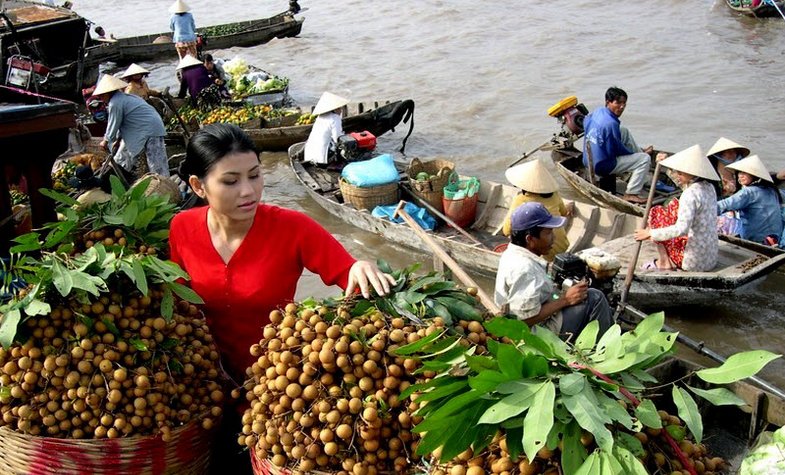
One of the main draws of Vietnam’s floating markets is the incredible array of fresh, locally sourced produce on offer. The markets are a true celebration of the country’s diverse and flavorful culinary heritage, with vendors showcasing a wide variety of fruits, vegetables, herbs, and more.
Tropical Fruits
The Mekong Delta region is renowned for its abundance of tropical fruits, many of which are showcased at the Floating Market Vietnam. Visitors can indulge in exotic offerings such as rambutan, dragonfruit, longan, jackfruit, and the iconic durian, with its distinctive aroma and flavor.
- Rambutan: A unique fruit with a vibrant red spiky exterior and a sweet, translucent flesh.
- Dragonfruit: A striking pink or yellow fruit with a cactus-like exterior and a mildly sweet, refreshing taste.
- Longan: Small, round fruits with a thin, brown shell and a sweet, juicy flesh.
- Jackfruit: A massive, spiky fruit with a unique flavor and texture, often used in savory dishes.
- Durian: The “King of Fruits,” durian is renowned for its pungent aroma and creamy, custard-like flesh.
Vegetables and Herbs
Vietnamese cuisine is known for its fresh, flavorful, and herb-infused dishes, and the floating markets are a prime source for the necessary ingredients. Vendors sell an array of locally grown vegetables and fragrant herbs, such as:
- Vegetables: Water spinach, bitter melon, long beans, and various leafy greens.
- Herbs: Lemongrass, Thai basil, mint, cilantro, and more.
Seafood and Meat
With the Mekong Delta’s proximity to the sea and the network of rivers and canals, the floating markets are a hub for fresh seafood and meat. Vendors sell a diverse selection of fish, shrimp, crabs, and other seafood, as well as poultry and meat products.
Cultural Significance of Floating Market Vietnam

Beyond their economic importance, floating markets in Vietnam hold significant cultural and social value, deeply intertwined with the local way of life and traditions.
Community Gathering Places
Floating markets serve as more than just commercial centers; they are also vibrant community gathering places where locals come together to socialize, exchange news, and strengthen their bonds. These markets foster a sense of belonging and reinforce the cultural identity of the region.
Preserving Traditions
The floating markets are a living embodiment of Vietnam’s rich cultural heritage, preserving traditional practices and values. From the intricate boat designs to the unique trading customs and haggling techniques, these markets showcase the resilience and adaptability of local communities.
Culinary Heritage
The floating markets are a celebration of Vietnam’s diverse culinary heritage, showcasing the country’s incredible array of fresh produce, spices, and traditional dishes. Visitors can immerse themselves in the aromas and flavors of authentic Vietnamese cuisine, gaining a deeper appreciation for the region’s culinary traditions.
Sustainable Livelihood
For many local communities, the Floating Market Vietnam are not just a cultural attraction but also a crucial source of livelihood. These markets provide a sustainable means of earning a living while preserving traditional practices and promoting local economic development.
Tips for Visiting Floating Markets in Vietnam

To make the most of your experience at Vietnam’s floating markets, here are some essential tips to keep in mind:
Plan Your Visit Accordingly
The floating markets are at their liveliest and most vibrant in the early morning hours, typically between 5 AM and 8 AM.During this time, you’ll witness the hustle and bustle of vendors setting up their boats, trading goods, and interacting with customers. Arriving early also allows you to beat the crowds and enjoy a more authentic market experience.
Bring Cash and Small Change
While some vendors may accept electronic payments, cash is still the preferred method of transaction at most Floating Market Vietnam. It’s essential to bring small denominations of Vietnamese dong to make purchasing items easier and more convenient. Having small change on hand will also help you negotiate prices and make quick transactions.
Be Respectful of Local Customs
When visiting floating markets in Vietnam, it’s crucial to respect the local customs and traditions. Avoid haggling aggressively or touching items without intending to purchase them. Remember that bargaining is a common practice, but do so respectfully and with a smile. Engaging with vendors in a friendly and polite manner will enhance your overall experience and leave a positive impression.
Try Local Delicacies
Floating markets are not just about shopping for fresh produce; they also offer a unique opportunity to sample local delicacies and street food. Be adventurous and try traditional Vietnamese dishes like banh mi (Vietnamese sandwich), pho (noodle soup), fresh spring rolls, and various fruit juices. Exploring the culinary offerings at the market will give you a taste of authentic Vietnamese flavors and culinary traditions.
Capture the Moment
Don’t forget to bring your camera or smartphone to capture the vibrant colors, bustling atmosphere, and picturesque scenery of the floating markets. The unique sights, sounds, and smells of these markets make for excellent photo opportunities, allowing you to preserve memories of your visit and share the beauty of the experience with others.
Evolution of Floating Market Vietnam
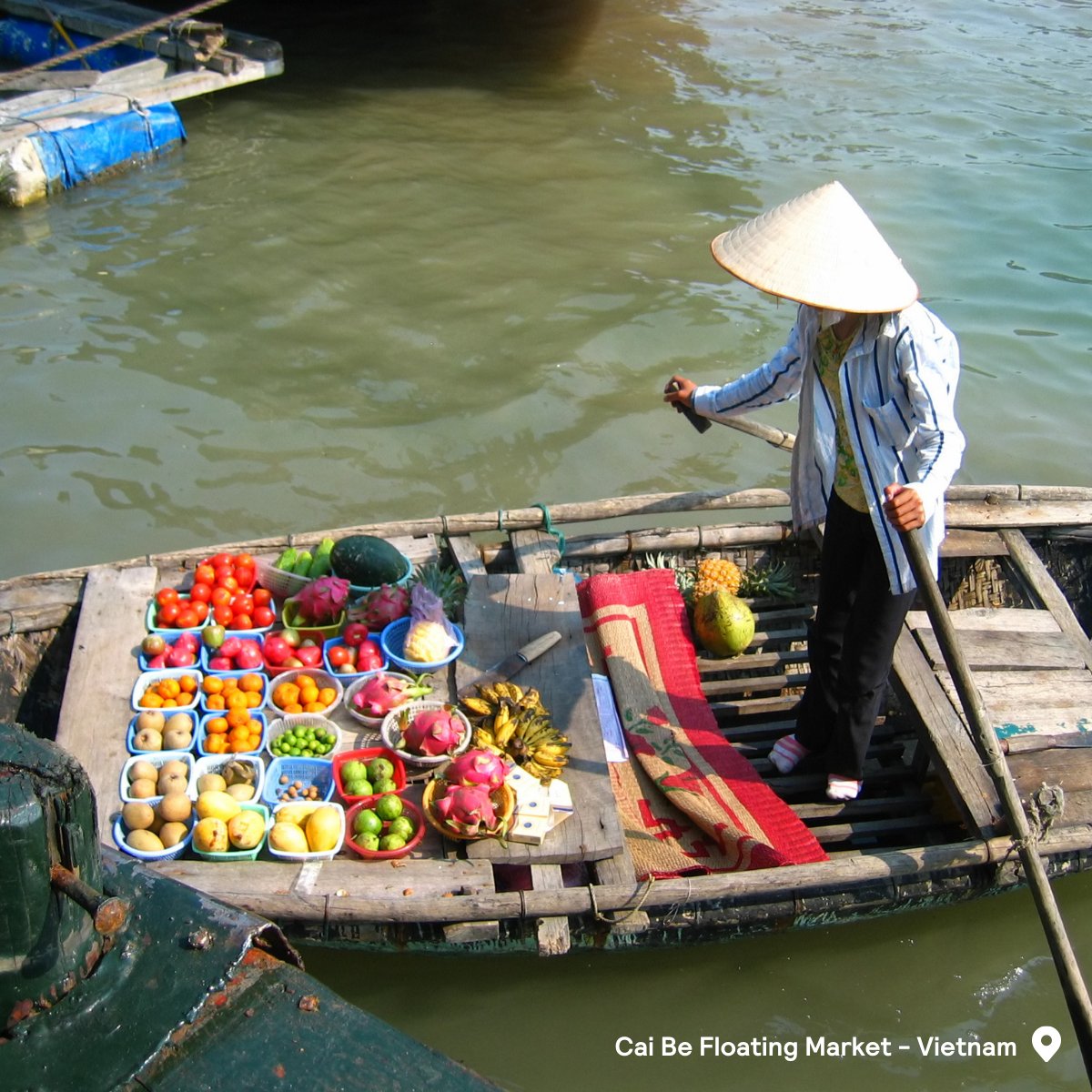
The evolution of Floating Market Vietnam reflects the changing dynamics of trade, transportation, and tourism in the region. From traditional wooden boats to modern motorized vessels, these markets have adapted to meet the demands of a rapidly evolving economy and society.
Historical Roots
Floating markets have been a part of Vietnamese culture for centuries, dating back to a time when waterways were the primary means of transportation and commerce. These markets served as vital hubs for trading agricultural products, seafood, handicrafts, and other goods among local communities along the rivers and canals.
Modernization and Infrastructure Development
With the advent of roadways, bridges, and modern transportation systems, the role of floating markets in Vietnam has evolved. While some traditional markets continue to thrive, others have faced challenges due to changes in consumer preferences and competition from land-based markets. To remain relevant, many floating markets have integrated modern amenities such as refrigeration, electricity, and online connectivity to attract vendors and visitors.
Tourism Boom
In recent years, Floating Market Vietnam have experienced a surge in tourism interest, drawing visitors from around the world eager to experience the unique charm and cultural heritage of these markets. This influx of tourists has led to both opportunities and challenges for local communities, as they navigate the delicate balance between preserving tradition and meeting the demands of a growing tourism industry.
Environmental Concerns
As floating markets become increasingly popular tourist destinations, there is a growing awareness of the need to protect the fragile ecosystem of the Mekong Delta and other waterways. Pollution, overfishing, and habitat destruction pose significant threats to the sustainability of these markets and the livelihoods of those who depend on them. Efforts are underway to promote eco-friendly practices, sustainable tourism initiatives, and conservation measures to safeguard the future of floating markets in Vietnam.
Impact of Tourism on Floating Markets in Vietnam
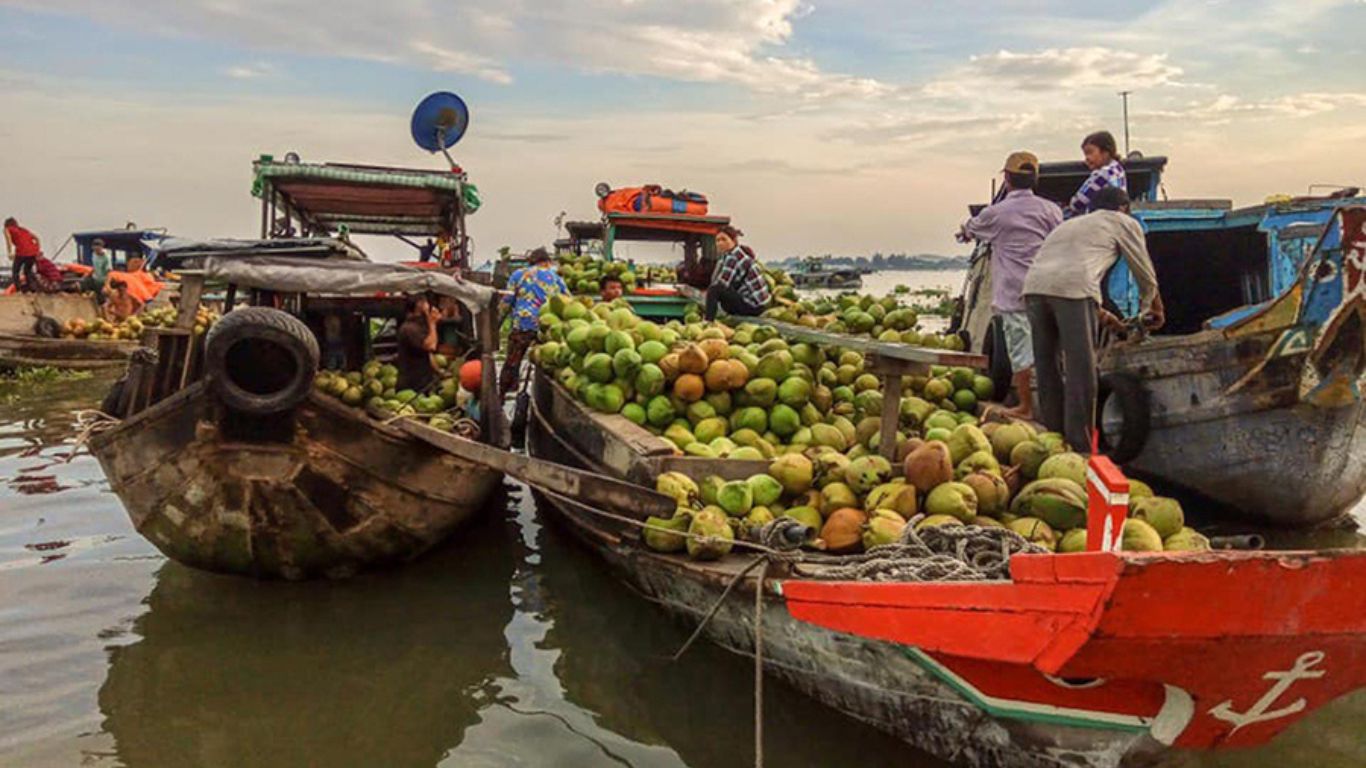
The rise of tourism in Vietnam has had a profound impact on the country’s floating markets, influencing everything from market dynamics and vendor practices to cultural preservation and economic development. While tourism brings opportunities for growth and exposure, it also presents challenges that require careful management and sustainable solutions.
Economic Opportunities
Tourism has injected new life into many Floating Market Vietnam, providing vendors with additional income streams and expanding market reach beyond local communities. The influx of tourists has created demand for unique souvenirs, handicrafts, and culinary experiences, prompting vendors to diversify their offerings and cater to a broader customer base.
Cultural Exchange
Tourism has facilitated cultural exchange and dialogue between local communities and international visitors, fostering mutual understanding and appreciation for Vietnam’s rich heritage. Visitors have the opportunity to learn about traditional practices, craftsmanship, and culinary traditions directly from the vendors, creating meaningful interactions and promoting cultural preservation.
Preservation Challenges
While tourism can help raise awareness and support for the preservation of floating markets, it also poses challenges to maintaining authenticity and integrity. The commercialization of traditional practices, influx of mass-produced goods, and pressure to cater to tourist preferences can erode the unique character and charm of these markets. Balancing the needs of tourism with the preservation of cultural heritage is a delicate task that requires collaboration between stakeholders and community members.
Sustainable Tourism Practices
To mitigate the negative impacts of tourism on floating markets, sustainable tourism practices are essential. Responsible tourism initiatives focus on minimizing environmental footprint, supporting local economies, and respecting cultural traditions. By promoting eco-friendly transportation, reducing waste, and engaging in fair trade practices, tourists can contribute to the long-term sustainability of Floating Market Vietnam.
Unique Features of Floating Markets in Vietnam
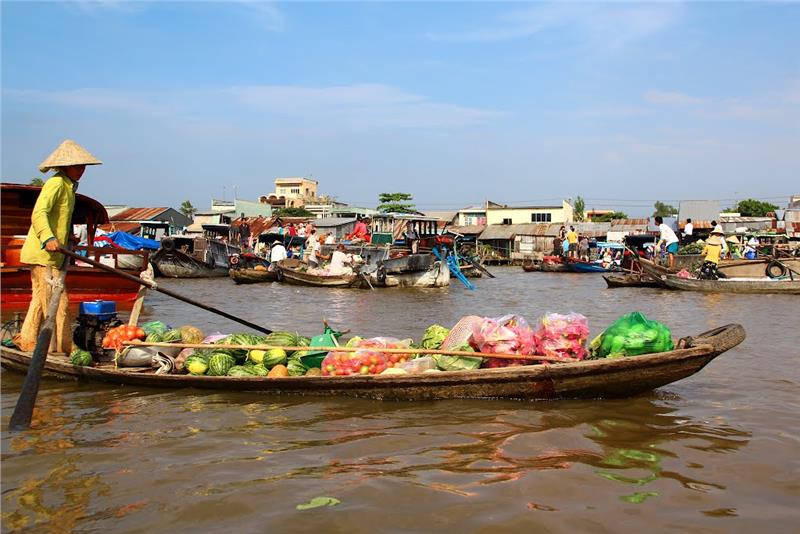
Floating Market Vietnam are distinguished by their vibrant atmosphere, diverse offerings, and rich cultural heritage. These unique features set them apart from traditional land-based markets and make them a must-visit destination for travelers seeking an authentic and immersive experience.
Scenic Waterway Setting
One of the most striking features of Floating Market Vietnam is their picturesque setting along the tranquil waterways of the Mekong Delta and other river regions. Visitors can cruise along meandering rivers, lined with lush greenery and stilt houses, while observing the colorful boats laden with fresh produce and goods. The natural beauty of the surroundings enhances the sensory experience of the markets, creating a serene and enchanting ambiance.
Boat-to-Boat Shopping
Unlike conventional markets where vendors are stationary, floating markets allow for boat-to-boat shopping, where buyers can approach sellers directly on the water. This unique mode of transaction adds an element of excitement and novelty to the shopping experience, as visitors navigate through a maze of boats, each offering its own specialty products and services. The dynamic and interactive nature of boat-to-boat shopping fosters personal connections and cultural exchange between vendors and customers.
Culinary Delights
Food plays a central role in the allure of floating markets, with vendors showcasing an array of fresh produce, street snacks, and regional specialties. Visitors can sample traditional Vietnamese dishes prepared on the spot, such as banh xeo (sizzling pancakes), hu tieu (noodle soup), and che (sweet dessert soup). The markets are a paradise for food enthusiasts looking to explore the diverse flavors and ingredients of Vietnamese cuisine in an authentic and lively setting.
Cultural Performances
In addition to shopping and dining, floating markets often feature cultural performances and entertainment that highlight the artistic talents and traditions of the local communities. Visitors may be treated to live music, folk dances, water puppet shows, and other cultural displays that showcase the creativity and heritage of the region. These performances add an extra layer of depth and immersion to the market experience, allowing visitors to engage with Vietnamese culture in a meaningful and memorable way.
Future of Floating Market Vietnam
As Vietnam continues to develop and modernize, the future of floating markets faces both challenges and opportunities. Preserving the cultural heritage, environmental sustainability, and economic viability of these markets will require a concerted effort from government authorities, local communities, and responsible tourists alike.
Sustainable Development
Sustainable development practices are essential to ensuring the long-term viability of Floating Market Vietnam. This includes implementing eco-friendly initiatives to protect the waterways, promoting fair trade practices to support local vendors, and investing in infrastructure improvements to enhance market accessibility and safety. By adopting a holistic approach to sustainable development, floating markets can thrive while preserving their unique charm and cultural significance.
Cultural Preservation
Preserving the cultural authenticity of floating markets is paramount to maintaining their appeal and relevance in a rapidly changing world. Efforts to safeguard traditional practices, artisanal craftsmanship, and indigenous knowledge must be prioritized to prevent the erosion of cultural heritage. Education, heritage conservation programs, and community engagement initiatives can help ensure that future generations inherit the legacy of Vietnam’s floating markets.
Responsible Tourism
Tourism plays a pivotal role in shaping the future of floating markets, making responsible travel practices essential for sustainable growth. Tourists can support local communities by patronizing small-scale vendors, respecting cultural norms, and minimizing their environmental impact. By choosing ethical tour operators, participating in community-based activities, and advocating for cultural preservation, visitors can contribute positively to the preservation and prosperity of floating markets in Vietnam.
Innovation and Adaptation
In an era of rapid technological advancement and global connectivity, floating markets must innovate and adapt to meet the changing needs and preferences of consumers. Embracing digital technologies, online marketing platforms, and e-commerce solutions can help vendors expand their market reach, attract new customers, and diversify their product offerings. By combining traditional practices with modern innovations, floating markets can stay relevant and competitive in the evolving marketplace.

Conclusion
Floating Market Vietnam are not just places to buy and sell goods; they are living reflections of the country’s rich cultural tapestry, culinary diversity, and communal spirit. These markets serve as vibrant hubs of activity, where locals and visitors alike come together to experience the sights, sounds, and flavors of traditional Vietnamese life.
From the iconic Cai Rang Floating Market to the lesser-known gems like Nga Nam Floating Market, each market offers a unique glimpse into the daily rhythms and rituals of riverside communities. The traditional boats, the bountiful produce, the cultural performances—all combine to create an unforgettable sensory experience that captures the essence of Vietnam’s waterborne heritage.
As these markets navigate the currents of change brought by tourism, modernization, and environmental challenges, it is imperative that we recognize and appreciate their significance as more than just tourist attractions. They are living embodiments of history, resilience, and community, deserving of our respect, support, and stewardship for generations to come. So, whether you’re navigating the waters of the Mekong Delta or savoring a bowl of steaming pho on a bustling boat, take a moment to immerse yourself fully in the magic of Vietnam’s floating markets—a world unto themselves, where tradition meets modernity, and the river flows endlessly on.




